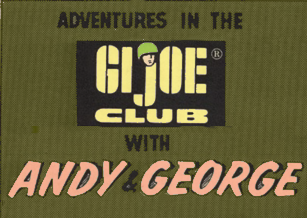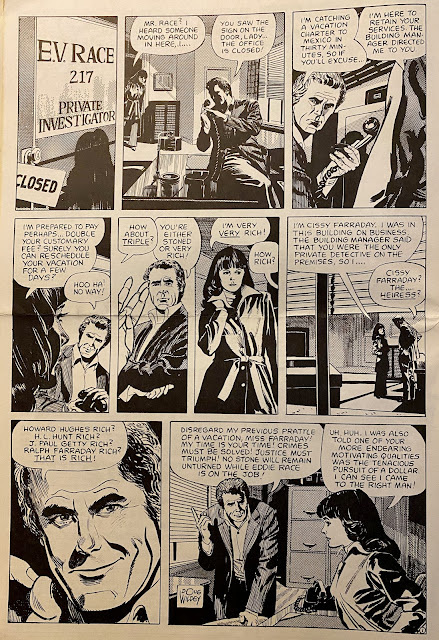I came across the remains of my Action Man/G.I. Joe toys recently, and it brought to mind those wonderful ads on the inside back page of DC comics from 1966, which painted a world of Action Man/G.I. Joe toys to which I could only aspire, brought to life in the comic strip “Adventures in the G.I. Joe Club with Andy and George”.
Artist Irv Novick is chiefly remembered these days for his collaborations with writer Frank Robbins on Batman following the character’s re-invention in 1969, but Novick had had a storied career both in comics and advertising, and it was this combination of skills, plus the sponsorship of colleague and friend Robert Kanigher, that lead Novick to illustrate a series of vignettes - a story about two wholesome pals - Andy and George - that ran over ten successive months across the DC comic line in books cover dated April 1966 through January 1967.
Prior to the appearance of the Andy & George strip, Hasbro had previously used the ad space for more traditional photo-based copy, showing G.I. Joe action figures in various costumes, but the element of adventure and narrative was missing. The idea of creating a comic strip that created scenarios for the G.I. Joe’s to be acted within was a stoke of genius. Andy and George would integrate all newly released sets into their play scenarios and built scale dioramas for their troops, giving kids some ideas on how to play with their G.I. Joes, and also hopefully get boys to identify with Andy and George.
Comic books were well suited to "content marketing", perhaps more so that any other printed media. Today, when you hear “content marketing” the mind tends to think of blogs, Facebook, Instagram and viral YouTube videos. But content marketing has been around far longer than digital. Because content marketing is about Storytelling, and humans have told stories for as long as there has been history. Our attention will always go to those who tell great stories, whether they be directors, writers, historians, comic book artists or brands.
And so the idea of weaving an on-going storyline, aligned as much as possible to the stories within the pages of DC's War comics, but extending into the superhero line, was focused on Andy & George's military objective : to get as many boys as possible to sign up with the club at G I Joe Club at 50 cents a pop.
At this time, Novick was one of the major artists on DC’s war books, his name becoming mentioned in the same breath as Joe Kubert and Russ Heath. The first ad premiered in parallel with Novick’s artwork in Our Fighting Forces #99 “No Mercy In Vietnam” and while the ads ran, Novick contributed war book artwork to Our Fighting Forces, Our Army at War, All-American Men of War , G I Combat and Captain Storm, all under the editorship of Robert Kanigher.Unlike the artwork within the main pages of the comic, the artwork for the ads was Black & White, with watercolour shading, always printed on the shiny inside back cover of the comic. The placing of the ad was strategic - it was the last item to be in the reader's mind before they closed the comic book.
Unlike some of the comic book stories , there were to be no overt references to the war in Viet-Nam. Reading through the letter columns of Kanigher's war books, some young male readers were voicing concerns about possibly being drafted for service in Viet-Nam within a few years. And so other than the introduction of a Green Beret later in the series, the strips focused more on the "Good War" of WWII , with a nod to the Space Race that captured boys’ imaginations.
The ads were not confined to just DC's War Books, but appeared in all superhero and humour titles, regardless of target gender audience. Of the 32 titles published with the April 1966 cover date, only the six romance comics did not run the ads. Even Lois Lane, Wonder Woman and Bob Hope titles ran the ads.
Looking at the 10 strips in sequence as they appeared over the ten month period, story dynamics start to emerge. Of the two boys, George is the leader. He's the guy who generally gets given the toys and leads on making the suggestions of where and how to play with them. Andy generally acquiesces. George is the spokesman for the company, and lords it over Andy.
Let's take a look at the ads in sequence, as published primarily in the War titles where Novick invariably contributed a story in the same issue that month:
Ad #1 : Apr 1966 Our Fighting Forces #99 "Arctic Adventure"
 |
| © Hasbro 1966. Irv Novick's first Andy & George ad. |
 |
| © DC. Splash page to accompanying Irv Novick illustrated story |
Ad #1 introduces George & Andy building a Winter Battle Scene. George recommends using Soap Powder as a substitute for authentic snow. They both seem to have GI Joe’s with Parka gear. No mention is made of George’s mother’s reaction to losing a month's supply of Tide.
Ad #2 : May 1966 Our Army At War #167 "Jeep and Bazooka"
The second ad to run features the 5-Star Jeep and Bazooka as the stars. George has obviously got the Jeep as a present. The Jeep was not cheap. I remember that I desperately wanted one, as my cousins had been given one.
Ad #3 : Jun 1966 All-American Men of War #115 "Deep Sea Diver"
George gets the Deep Sea Diver suit. He already has the cool frogman set that he brings into the action. No mention that the frogman will probably suffer from the “bends” as he swims at the same depth as the deep sea diver. [Personal aside - I got the Action Man deep sea diver set for my 9th birthday. The helmet damaged the nose of my Action Man, plus my parents would not let me fill the bath up to sufficient depth to raise and lower Action Man to/from the sea bed.]
Ad #4 : Jul 1966 Our Fighting Forces #101 "Combat Squad Gets Decorations"
George has seen that there are 15 different costumes for G.I. Joe/Action Man. George wants to dress his action figures in Combat squad fatigues, whereas Andy is more preoccupied with getting the lads into dress uniforms. George is definitely the gung-ho type; Andy the sensitive lad.
Ad #5 : Aug 1966 Our Fighting Forces #102 "A Front Line in the Back Yard"
George taking the lead to play with the GI Joe’s in the muddy backyard. Andy agrees. George is very influenced by the ads he has seen on TV, deciding that it would be more fun with multiple GI Joes.
Ad #6 : Sep 1966 Our Army At War #171 "Inspection Commendation"
Andy’s Dad is a bit of a martinet. He used to carry an M-1 rifle in the Army. He is off-stage, coming to inspect the foot lockers. He calls out “Attenshun!”.
Ad #7 : Oct 1966 Star Spangled War Stories #129 "Assignment: Outer Space"
George has just got the Mercury Space Capsule as a present. Andy thinks it’s great. He quickly removes his GI Joes combat kit and dresses him an an astronaut for a spacewalk. [Aside: my friend Steve Redford got the Action Man Mercury Capsule as a present ; I was very envious.]
Ad #8 : Nov 1966 Showcase #65 "New Man Joins Platoon"
The narrative shifts back to the military. Andy finally gets a new toy of his own. A Green Beret GI Joe as featured in Viet-Nam (and in the John Wayne movie “The Green Berets”.
Ad #9 : Dec 1966 Batman #188 "Battlegrounds of the World"
Definitely a move to WWII here. Andy has taken the lead to set up a complete war gaming environment spread across a local park, with separate sections for different soldiers of different wars and countries. (Have his parents come into some money?). Whatever, but Andy is going all-out to make George’s previous efforts seem small potatoes.
Ad #10 : Feb 1967 Our Fighting Forces #105 "20 Fathoms Under the Sea"
Featuring the Frogman Sea Sled, which George has (yet again) got as a present.
And then suddenly in Feb 1967, the campaign ended. Never to return.
And that was it. Andy and George’s job was done.
I have no idea who wrote the copy, but would not be surprised if Kanigher himself had not had a hand in it ; he kept iron control on the content of his war books.
By the end of the campaign, 400,000 boys had joined the G.I. Joe Club, exclusively as a result of reading Irv Novick’s strip. That was $200,000 of membership dues at 50-cents a pop, plus all the toys that were bought as a result. Whether Novick shared in the wealth, I do not know.
No-one mentioned in the letter cols that Novick was doing the art chores on Andy & George, despite Novick's artwork being praised by readers of the stories he drew. The only allusion I could find to Novick moon-lighting in the advertising field was Bob Kanigher's comment in GI Combat #119 in response to a question of keeping artists on specific strips.
Kanigher says “Many DC artists are in great demand in other media because of their excellence, such as newspapers, magazines, advertising, etc.; Joe Kubert, Russ Heath and Irv Novick immediately spring to mind; a certain amount of editorial juggling is needed.”
I probably first saw these ads in the December 1966 issue of Batman, which was on UK spinner racks around end of February 1967. I was disappointed that the G.I. Joe club was only open to residents of United States and Canada, and if I could have persuaded my parents to stump up 50c, I would have done.
I was a huge Action Man/G.I. Joe fan in the late sixties. I later made a 10 second stop-motion 8mm movie, a frame of which is shown here. Action Man/G.I. Joe is stood on the sideboard within which my comics were piled in two stacks.
 |
| © Ian Baker. Action Man in action. |
Wither Andy and George? They grew up. George went on to become Don Draper in Mad Men and Andy became a social worker.














































